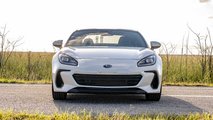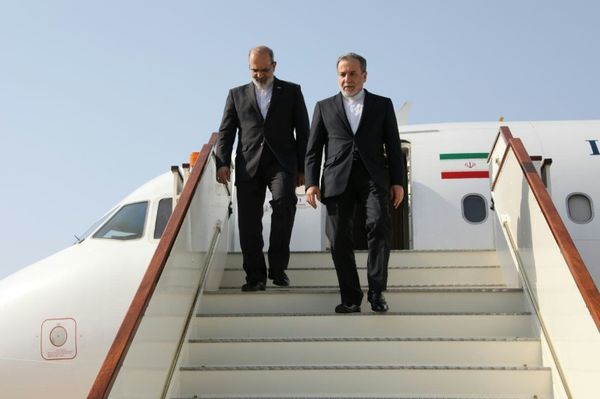
Design | Comfort | Technology | Performance | Safety | Fuel Economy | Pricing | FAQ
There aren't as many affordable performance coupes as there used to be, sadly. But if you know where to look, there are still great options to be had. The base Ford Mustang EcoBoost and the Chevrolet Camaro with the turbocharged 2.0-liter are two punchier options, the Miata RF is a stylish choice, and the Toyota GR86 and Subaru BRZ siblings use their agility to their advantage.
When it comes to the Subaru BRZ specifically, the 2022 model year brings with it a number of significant updates. Eyesight active safety equipment and improved technology bring the sports car into the modern age, while reworked structural components make the coupe more livable. And much to the delight of forum posters and social media commenters everywhere, the BRZ gets a noticeable power increase.
A vehicle's ratings are relative only to its own segment and not the new-vehicle market as a whole. For more on how Motor1.com rates cars, click here.
| Quick Stats | 2022 Subaru BRZ Limited |
| Engine | 2.4-Liter H4 |
| Output | 228 Horsepower / 184 Pound-Feet |
| 0-60 MPH | 6.5 Seconds (Automatic) |
| Base Price | $27,995 + $995 Destination |
| As-Tested Price | $33,290 |
Gallery: 2022 Subaru BRZ: Review







- Exterior Color: Crystal White
- Interior Color: Black / Red
- Wheel Size: 18 Inches
The BRZ puts on a happier face for 2022 thanks to its upturned front bumper and dimple-like vents. The headlights are slimmer and sharper too than they were in the previous model, and this Limited trim’s 18-inch alloys and low-profile Michelin Pilot Sport 4 tires fit the wheel wheels perfectly.
This new BRZ, overall, has a much cleaner design. The body siding is smoother with better detailing, the rear haunches meld more seamlessly into the rear end, and the ducktail spoiler on the trunk lid caps off the design with a flourish. Both the BRZ and its Toyota GR86 sibling have the profile of a high-tech running shoe.
The interior of the BRZ feels more familiar, but noticeably improved. Black leather with red accent stitching covers the steering wheel, shift knob, handbrake, and armrests on the door panels. The seats sport the same color combo but in a mix of real leather and faux Ultrasuede – which does a decent job of mimicking real Alcantara – with red leather accents running vertically along the seats.
The cabin layout remains driver-focused, with limited clutter in the center console and only a few new controls on the steering wheel; in the previous model, there were none at all. Three simple dials beneath the screen control the temperature settings while silvery toggles below that help manage syncing and air circulation. All in all, this is a very streamlined, well-laid-out interior.
Ride quality was never a high point of BRZ, and although it improves slightly here, this still isn't a great car for long road trips. The BRZ’s ride quality is firm and the low-profile tires contribute to a lot of noise. Talking to your passenger requires an above-average speaking volume.
The back seats of the BRZ, as they were in the previous model, are basically unusable. The 29.9 inches of legroom behind the front seats might work for a small child, but no one larger – that's assuming you can squeeze into the back seat at all. The manually folding front seats leave barely enough space for an adult to squeeze through. And with just 6.3 cubic feet of cargo room, you won't be able to fit much in the trunk.
My suggestion? Don’t bother with second-row passengers at all. You and your front rider will be plenty comfy in the sport bucket seats, which contour perfectly to the body and offer ample bolstering, plus impressive butt and back support. And there is heating functionality on both front seats. Although, even on the highest trim, the seats are only manually adjustable and in six-different ways.
- Center Display: 8.0-Inch Touchscreen
- Instrument Cluster Display: 7.0-Inch Productivity Screen
- Wireless Apple CarPlay or Android Auto: No
There's nothing inherently fancy about the BRZ's new tech, but the central touchscreen does grow by one inch compared to last year – from 7.0 to 8.0 inches. And now this setup comes standard across the board with the latest version of Subaru's Starlink infotainment system. Touch responsiveness improves, but it's still laggy, and while the layout itself is cleaner and more cohesive, it already feels dated. The graphics and menu options aren't as crisp as they should be.
Wired Apple CarPlay and Android Auto connections are standard on both trims, as is navigation, satellite radio, and a 7.0-inch instrument cluster that has a retro digital vibe. The display features a central tachometer with adjustable settings on the left side for advanced settings like lap times and G forces. On the right side is where more basic readouts for fuel economy and temperatures live.
Compared to last year’s minimalist steering wheel design, which had no buttons at all, Subaru did add actual, tactile buttons to the wheel this year. For basic audio and menu controls while on the move, the new steering-wheel buttons are a welcomed upgrade.
- Engine: 2.0-Liter H4
- Combined Output: 228 Horsepower / 184 Pound-Feet
- Transmission: Six-Speed Automatic
Power, or lack thereof, was a problem for the previous Toyota GR86 and Subaru BRZ. Last year's naturally aspirated 2.0-liter boxer four-cylinder produced 205 horsepower and 156 pound-feet – some would argue not enough. This year, the BRZ hit the gym. Now with a larger, still naturally aspirated 2.4-liter engine, those numbers improve to 228 hp and 184 lb-ft of torque – and the gains are noticeable.
The extra 28 lb-ft peak at a generous 3,700 RPM, launching the BRZ off the line with more gusto. This car is downright zippy. While the previous BRZ huffed and puffed and whined its way to 60 miles per hour, this car sprints there with purpose, managing a 60 time of 6.0 seconds with the manual or 6.5 seconds with the automatic tested here. Only when you get up to the rev limiter does the engine sound buzzy.
The BRZ is still down on power compared to the Mustang and Camaro. The Ford produces at least 310 horsepower while the Chevy promises 275 hp. But it’s in the corners where the BRZ really excels. For 2022, Subaru improved the BRZ's torsional rigidity by about 50 percent, which yields flatter cornering and better balance. If you thought this car was agile before, it's even more satisfying to fling around now. The extra grip from the new Michelin Pilot Sport 4 summer tires (215/40) – standard on the Limited – helps keep the BRZ composed, providing more grip at all four corners than the bicycle-thin rubber of the previous base model.
Having driven the Toyota 8R6 with the six-speed manual, I can say definitively that the row-your-own shifter is still the way to go. But, the six-speed automatic is still a good transmission; it shifts decisively and loves to hang right at the redline if you keep it in Sport mode. But flicking the paddles does result in a slight half-second delay, so it's not as quick as it could be.
The electric power-assisted steering is lighter here than it was in the previous model and requires less effort than a comparable Mustang or Camaro. But the response time is still plenty quick for sporty driving, and there’s generous feedback from the pavement to your fingertips.
- Driver Assistance Level: SAE Level 2 (Hands-On)
- NHTSA Rating: Not Tested
- IIHS Rating: Top Safety Pick Plus
If you opt for the automatic transmission on the Limited model, Subaru gives you access to its advanced Eyesight active safety suite at no extra cost. Buyers of the manual model miss out entirely. Eyesight includes adaptive cruise control with lane centering, automatic emergency braking, and lane-keep assist, while the Limited model also gains rear automatic emergency braking and high-beam assist.
Subaru’s Eyesight safety technology made long-distance highway driving a breeze. Flicking the adaptive cruise control stalk activated the system, keeping the car centered in the lane while applying smooth throttle and braking inputs with the flow of traffic. My only issue was how overly sensitive – and annoying – the lane departure warning system was. It emitted a high-pitch beep if the car got too close to the lane, and you have to dig into the touchscreen to deactivate it.
The tradeoff of extra power is, of course, lower fuel economy. The BRZ drops from 24 city, 33 highway, and 27 combined in the previous model to 21 city, 30 highway, and 25 combined in this new version – both equipped with the automatic transmission. That said, the 25 combined mpg in the automatic BRZ matches the Toyota 86 – and in a class that consists of two, the BRZ and 86 offer solid efficiency.
The 2022 Subaru BRZ starts at $28,990 with the $995 destination fee included, while the Limited model costs $31,490. Adding the automatic transmission to either trim is an $1,800 option, while all seven paint options are free of charge. So even a fully-loaded Limited model with the automatic transmission, like the one tested here, only costs $33,290 with every factory option equipped.
Its cousin, the Toyota GR86, is a touch more affordable to start, asking $28,710. The Premium model, though – which is equal to the BRZ Limited tested here – costs $31,735 before options, which is just a few hundred dollars more than a similar BRZ.
The base Mustang and Camaro both undercut the BRZ. The Ford starts at $28,600 with destination fees included, while the Chevy is just $26,195 with the four-cylinder. The Mazda Miata RF is the only option pricier than the BRZ, asking $36,910 to start.
Even with a pricier MSRP, though, the BRZ and/or the GR86 are still worth the cash. Subaru’s updated coupe keeps its excellent driving dynamics from last year, but now features more cheerful styling, slightly better tech, and most importantly, enough power to keep the naysayers interested.
BRZ Competitor Reviews:
FAQS
Is The Subaru BRZ A Fast Car?
The Subaru is powered by a 2.4-liter four-cylinder engine that produces 228 horsepower and 184 pound-feet, paired to either a six-speed manual or a six-speed automatic transmission. To 60 miles per hour, it takes the BRZ 6.0 seconds with the automatic and 6.5 seconds with the manual.
Which Is Better The Subaru BRZ Or The Toyota GR86?
The Subaru BRZ and the Toyota GR86 are nearly identical, with the same engine, horsepower, and transmissions. The Toyota is slightly more affordable than the GR86, starting at $28,710, while the BRZ costs $28,990.
Does The Subaru BRZ Come In Automatic?
Yes, the Subaru BRZ is available with an automatic transmission. Subaru offers a standard six-speed manual or an optional six-speed automatic depending on the trim.







